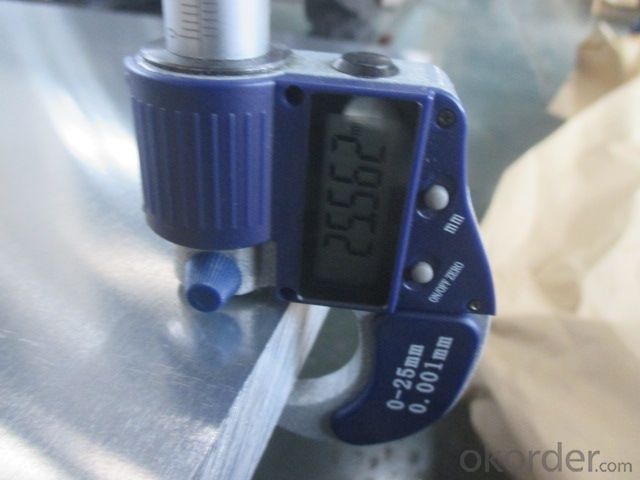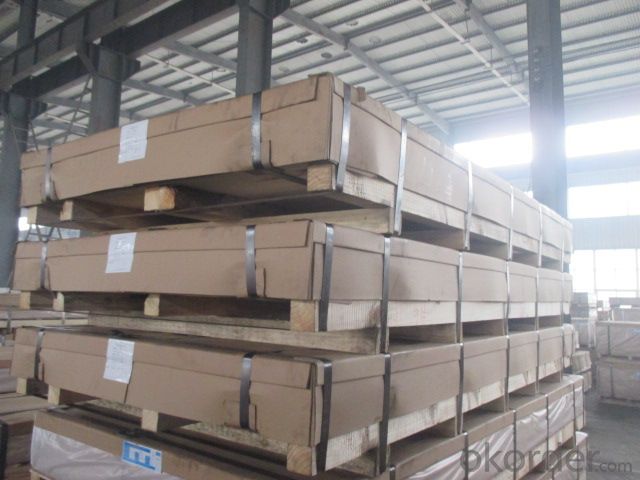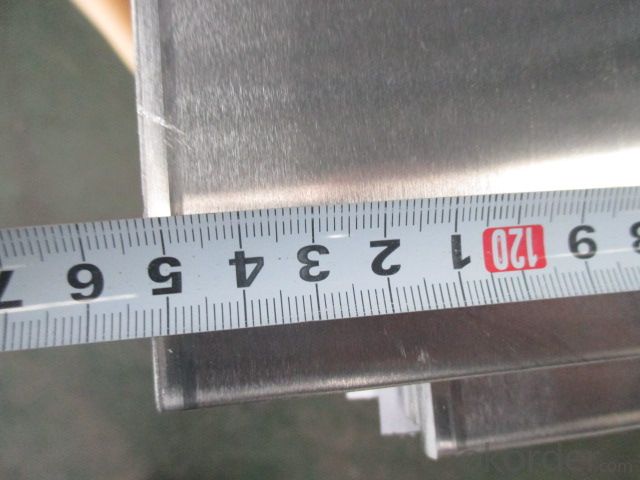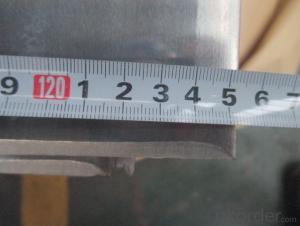Aluminium Plate With Discount Price In Our Waehouse
- Loading Port:
- Shanghai
- Payment Terms:
- TT OR LC
- Min Order Qty:
- 3 m.t
- Supply Capability:
- 200 m.t/month
OKorder Service Pledge
OKorder Financial Service
You Might Also Like
Item specifice
1.Structure of Product Description
Cold rolled aluminum sheet and hot rolled aluminium plate are all widely used in the field of construction field and decoration field, etc. There are many different grades, such as: 2000 series, 3000 series, 5000 series,2000series,8000 series, 6000series, etc. The detailed grade and temper and the alloy number is including as follows: 1010,1060,1070,2024, 3003, 3105, 5052,5754,5083,6061,6063,8011, etc.
The temper is include H14,H44,H112,O,F,h44,h24,h22,h14,etc. H114,etc.
2. Main features of the product
a. better price
b.Frist-Class Service.
c. Shortest service.
3. Image.



4. Product detailed sizes:
1000mm*2000mm, 1219mm*2438mm,1220mm*2440mm, 1250mm*2500mm,1500mm*3000mm, etc.
5. FAQ:
What is the quality standard?
---Usually our standard is GB3880-2006 or others.
What is the width range?
---It is from 500mm to 2500mm, etc.
---Normally it is around 3 tons/each size.
How many tons did you export in one year?
---Normally it is around 9000 tons totally.
Where is your client from?
---Normally they are aluminum sheet, checkered sheet,
mirror finish aluminium sheet, aluminum casting coil, etc.
- Q:how would you use aluminum to extract silver from film?just ideas please
- The silver in film is part of a silver salt (silver halides.) It is a very very small amount, probably less than 1 cent worth per roll. You would be a lot better off selling the film than trying to extract the silver from it. If you are hell bent on it, the first step is to expose the film to light. This will break the silver from the halides. Then you can go about trying to figure out how to get the silver apart from the film. I am sure it is possible, but it would involve a lot of work. I imagine you you would spend about $100 on ever $1 worth of silver you could extract.
- Q:What's the maximum size of 3 mm thick aluminum sheet?
- First look at tolerance taggingIf there is no tolerance, see the accuracy level of the workpiece and check the tolerance listA 3-4 mm deviation is acceptable if the magnitude is not noted and is of no importanceThat is, the 34mm can also be used if lower precision sizes can be addedOnly board class is generally down bias, there is very little difference
- Q:could aluminum sheet be attracted by magnet?
- no, it couldn't.
- Q:Are the aluminum sheets recyclable?
- Yes, aluminum sheets are highly recyclable. Aluminum is one of the most recyclable materials on the planet, and it can be recycled indefinitely without losing its quality. Recycling aluminum sheets requires less energy compared to producing new aluminum from raw materials, which has significant environmental benefits. The recycling process involves melting down the aluminum sheets to extract the metal, which can then be used to produce new aluminum products. Recycling aluminum sheets not only conserves valuable resources but also helps reduce greenhouse gas emissions and landfill waste. Therefore, it is highly recommended to recycle aluminum sheets whenever possible.
- Q:What kind of material is 2A12 aluminum sheet?
- The temperature is higher than 125 degrees C, and the strength of the 2024 alloy is higher than that of the 7075 alloy. Under the condition of hot state, annealing and new quenching, the formability is better, and the strengthening effect of heat treatment is remarkable, but the heat treatment process is strict.
- Q:Can aluminum sheets be perforated for decorative or functional purposes?
- Yes, aluminum sheets can be perforated for both decorative and functional purposes. Perforating aluminum sheets allows for the creation of intricate patterns or designs and also enhances the sheet's functionality by improving ventilation, reducing weight, or enhancing acoustic properties.
- Q:How does the thickness of aluminum sheet affect its strength?
- The strength of an aluminum sheet is directly influenced by its thickness. Generally, a thicker aluminum sheet will possess greater strength compared to a thinner one. This correlation arises from the fact that the thickness of the sheet determines the quantity of material present, ultimately impacting its ability to endure external forces or loads. Typically, the strength of a material is measured based on its capacity to withstand stress without deforming or failing. Thicker aluminum sheets have a larger volume of material, resulting in an increased number of atoms and bonds to counteract forces. Consequently, these sheets exhibit a heightened resistance to deformation or failure, thus rendering them stronger. Furthermore, thicker aluminum sheets boast a higher load-bearing capacity. Consequently, they can endure heavier loads or higher pressures without distorting or failing. The augmented thickness allows for a greater distribution of the load, thereby reducing the stress placed on individual atoms and bonds within the sheet. Nevertheless, it is crucial to acknowledge that there exists a limit to the thickness at which the strength of an aluminum sheet reaches a plateau. Once this threshold is surpassed, further increasing the thickness may not yield significant improvements in strength. This limitation arises from the influence of other material properties of aluminum, such as its crystal structure and grain boundaries, which also contribute to determining its strength. To conclude, the strength of an aluminum sheet is directly linked to its thickness. Thicker sheets possess more material, enabling them to effectively resist deformation or failure under stress. Furthermore, their increased thickness allows them to support heavier loads or endure higher pressures. However, it is important to recognize that there is a limit to the thickness at which the strength plateaus, as other material properties also come into play.
- Q:When Aluminium nitrate is heated , i got yellow amorphous solid which did not not melt on further heating. What compound is that?
- l would say you have mostly aluminum oxide as a product which probably contains some Nitrogen dioxide gas, a second product of the decomposition of aluminum nitrate. If I were you I would not heat nitrate salts as they can explode upon heating. they also need to be kept away from any kind of reducing agent such as powdered metals, or any fuels, reactions can be violent.
- Q:How does aluminum sheet perform in extreme temperatures?
- Due to its unique properties, aluminum sheet exhibits exceptional performance in extreme temperatures. One of its key advantages is its remarkable thermal conductivity, enabling it to efficiently transfer heat. This characteristic allows aluminum sheet to quickly adapt to extreme temperatures, preventing the occurrence of warping or cracking that may be experienced with other materials. Moreover, aluminum possesses a high melting point of approximately 660 degrees Celsius, rendering it highly suitable for usage in high-temperature environments. It remains structurally stable, retaining its strength and integrity even when subjected to intense heat. Additionally, aluminum exhibits a low coefficient of thermal expansion, resulting in minimal expansion and contraction in response to temperature fluctuations. This particular attribute enables aluminum sheet to maintain its shape and dimensions even when exposed to drastic temperature changes. Furthermore, aluminum showcases exceptional corrosion resistance, further augmented by the formation of a natural oxide layer on its surface. This oxide layer serves as a protective barrier against chemical reactions, safeguarding the aluminum from deterioration even in harsh environments or extreme temperatures. In conclusion, aluminum sheet demonstrates outstanding performance in extreme temperatures due to its high thermal conductivity, high melting point, low coefficient of thermal expansion, and excellent corrosion resistance. These properties establish it as a reliable choice for a multitude of applications, including the aerospace, automotive, and industrial sectors, where the ability to perform under extreme temperatures is of utmost importance.
- Q:How do you prevent galvanic corrosion when using aluminum sheets with saltwater?
- To prevent galvanic corrosion when using aluminum sheets with saltwater, there are several steps that can be taken: 1. Apply protective coatings: One effective method is to apply a protective coating to the aluminum sheets. This can be done by using specialized marine-grade paints or coatings that are designed to prevent corrosion in saltwater environments. The coating acts as a barrier between the aluminum and the saltwater, reducing the likelihood of galvanic corrosion. 2. Use isolation materials: Another approach is to use isolation materials, such as rubber or plastic gaskets, between the aluminum sheets and any dissimilar metals that may come into contact with them. These materials prevent direct contact between the aluminum and other metals, minimizing the risk of galvanic corrosion. 3. Galvanic corrosion inhibitors: Adding galvanic corrosion inhibitors to the saltwater can help mitigate the risk of corrosion. These inhibitors work by creating a protective layer on the aluminum surface, preventing the electrochemical reactions that lead to galvanic corrosion. 4. Cathodic protection: Employing cathodic protection techniques can also help prevent galvanic corrosion. This involves connecting the aluminum sheets to a sacrificial anode made from a more active metal, such as zinc or magnesium. The sacrificial anode corrodes instead of the aluminum, protecting it from galvanic corrosion. 5. Proper maintenance: Regularly cleaning and maintaining the aluminum sheets is crucial for preventing galvanic corrosion. Saltwater and other contaminants can accumulate on the surface, promoting corrosion. Cleaning the sheets with fresh water and removing any salt deposits can help prolong their lifespan and reduce the risk of galvanic corrosion. It is important to note that these preventive measures should be implemented in conjunction with proper material selection and design considerations. Consulting with corrosion experts or engineers who specialize in marine applications can provide further guidance on the specific requirements and best practices for preventing galvanic corrosion when using aluminum sheets with saltwater.
1. Manufacturer Overview |
|
|---|---|
| Location | |
| Year Established | |
| Annual Output Value | |
| Main Markets | |
| Company Certifications | |
2. Manufacturer Certificates |
|
|---|---|
| a) Certification Name | |
| Range | |
| Reference | |
| Validity Period | |
3. Manufacturer Capability |
|
|---|---|
| a)Trade Capacity | |
| Nearest Port | |
| Export Percentage | |
| No.of Employees in Trade Department | |
| Language Spoken: | |
| b)Factory Information | |
| Factory Size: | |
| No. of Production Lines | |
| Contract Manufacturing | |
| Product Price Range | |
Send your message to us
Aluminium Plate With Discount Price In Our Waehouse
- Loading Port:
- Shanghai
- Payment Terms:
- TT OR LC
- Min Order Qty:
- 3 m.t
- Supply Capability:
- 200 m.t/month
OKorder Service Pledge
OKorder Financial Service
Similar products
New products
Hot products
Hot Searches
Related keywords



























